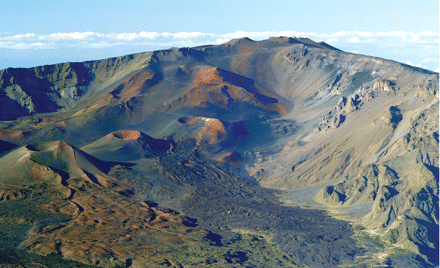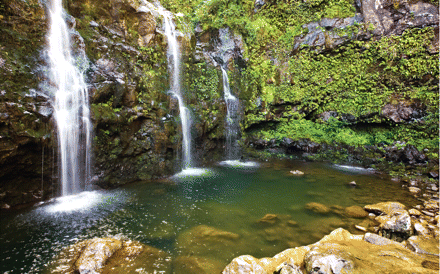Maui: Nothing's Missing Except the Ordinary
Abstract
It turns out that Maui may indeed be the fabled pot of gold at the end of one of many rainbows that often crown parts of the "Valley Isle."
Blessed with some of the world's most spectacular beaches, lush tropical valleys, dramatic waterfalls, and a color-streaked volcano, Hawaii's second-largest island would seem to have every element required of an earthly paradise. It would be a shame to visit Honolulu and not make plans to soak up some of Maui's riches.
Maui's 30 miles of beaches along its 120-mile coastline include ones isolated from civilization, such as Makena Beach—usually appearing on list's of the world's most beautiful—and bustling Ka'anapali, which is lined with luxury hotels and condominiums.
At Ka'anapali's northern end, next to the Sheraton Maui hotel, is Black Rock, a dramatic volcanic outcropping from which, Hawaiian legend has it, warriors leapt to their deaths to reunite with their ancestors. Today Black Rock is one of Maui's premier snorkeling sites. On most evenings, after a torch-lighting ceremony, a cliff diver leaps from the rock into the waters far below.
Another beach that gets rave reviews is Kapalua Bay Beach, a few miles north of Ka'anapali, which is in a quiet cove rife with colorful reef fish, thus another great spot for snorkelers.
On Maui's south shore, isolated Makena Beach, part of a state park, is a long wide stretch of soft yellow sand where it is never hard to stake out some territory away from other beach lovers. A smaller beach, separated by a volcanic rock and known as Little Makena Beach, is a popular spot for nude sunbathing, though it is illegal in Hawaii. For those who make the climb over the rock, there is a section where most people tend to be straight, and just past that, one that attracts gay and lesbian sunbathers.
Climb an Ancient Volcano
Perhaps Maui's leading attraction for visitors in the extinct volcano known as Haleakala, at the center of 27,000-acre Haleakala National Park in the island's region known as "upcountry." The island's highest peak, Haleakala means "house of the sun" in Hawaiian, because it was believed that standing at the mountain's peak, the demigod Maui lassoed the sun as it made its transit of the sky, thus causing its pace to slow and days to lengthen. The tortuous 38-mile drive from sea level to the top of the crater can take over two hours, but once at the summit views of the crater's layer-cake walls of multicolored rock will wow even the most jaded world traveler. Rising from the crater's floor are a series of cinder cones, each with its own mini-crater.

At Haleakala crater on Maui, you can marvel at or hike through a landscape of rainbow-hued lava rocks that looks like no place else on Earth and encounter native animal life unique to the 50th state.
Sunrise is the most popular time to visit Haleakala, and if that is your choice, remember to head out at about 3 a.m. or so. If you find yourself breathless, it may, however, be because of the thin air at 10,000 feet as much as from the amazing vistas. Bicycle trips down the mountain are one of Maui's signature experiences.
The Needle Beckons
If Haleakala only whets your appetite for additional natural wonders, a visit into the Iao Valley should be next on your agenda. The lush, 10-mile-long valley has paved pedestrian trails that lead to its featured attraction, the Iao Needle. The 1,200-foot, vegetation-covered outcropping is best viewed early in the day, since clouds often roll in and obscure its peak.
The Iao Valley holds a prominent place in Hawaii's history, since it was here in a 1790 skirmish that King Kamehameha I's army successfully battled forces of Maui's king Kahekili in an effort to unify the islands under his rule.
Driving the Road to Hana
To appreciate the riches of Maui's scenery, many visitors reserve a day to drive the coast-hugging road from the city of Kahalui to the small town of Hana on the untouristed eastern coast.

Dozens of waterfalls, dense tropical vegetation, and 54 bridges punctuate the Road to Hana. Allow a full day to admire the scenery or venture onto some of the well-marked hiking trails.
The winding road, which often narrows to one lane across the journey's many bridges, passes multiple waterfalls, oceanside cliffs, and abundant tropical greenery. At several pull-offs, you can follow hiking trails or just admire the scenery.
A Little Bit of Urban Life
If taking in all of nature's bounty has you longing for a little urban bustle, a detour to Maui's largest city, Lahaina, might be in order. Lahaina, just south of the resort area of Ka'anapali, is a former whaling center that in the early 1800s was the capital of the Kingdom of Hawaii. Its streets, particularly waterside Front Street, are lined with galleries, bars, restaurants—many with ocean views—and sites that let visitors get a glimpse of the island's history.
A self-guided walking trail leads visitors to more than a dozen interesting landmarks from more than 400 years of the region's history, focusing on its whaling past, the missionaries who spent decades trying to convert native Hawaiians to Christianity, and the European and Asian immigrants who built a thriving plantation life in the surrounding areas.
A top attraction in the center of Lahaina, and an excellent place to get some shelter from the Hawaiian sun, is an enormous banyan tree rising from 12 trunks that occupies a full city block, or about two-thirds of an acre.
More information about Lahaina is posted at <www.lahaina.com>. Additional information about Maui is posted at <www.gohawaii.com/maui>.



